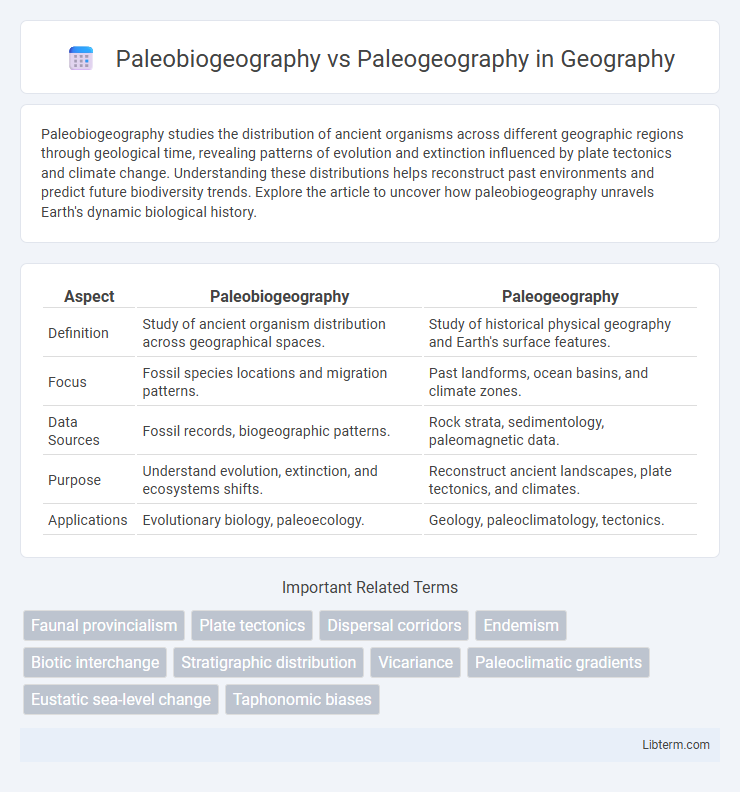Paleobiogeography studies the distribution of ancient organisms across different geographic regions through geological time, revealing patterns of evolution and extinction influenced by plate tectonics and climate change. Understanding these distributions helps reconstruct past environments and predict future biodiversity trends. Explore the article to uncover how paleobiogeography unravels Earth's dynamic biological history.
Table of Comparison
| Aspect | Paleobiogeography | Paleogeography |
|---|---|---|
| Definition | Study of ancient organism distribution across geographical spaces. | Study of historical physical geography and Earth's surface features. |
| Focus | Fossil species locations and migration patterns. | Past landforms, ocean basins, and climate zones. |
| Data Sources | Fossil records, biogeographic patterns. | Rock strata, sedimentology, paleomagnetic data. |
| Purpose | Understand evolution, extinction, and ecosystems shifts. | Reconstruct ancient landscapes, plate tectonics, and climates. |
| Applications | Evolutionary biology, paleoecology. | Geology, paleoclimatology, tectonics. |
Introduction to Paleobiogeography and Paleogeography
Paleobiogeography studies the distribution of ancient organisms and ecosystems across geological time, analyzing fossil records to understand patterns of biodiversity and biogeographic shifts. Paleogeography reconstructs past physical landscapes, including continental positions, ocean basins, and climate zones, to model Earth's surface changes over millions of years. Together, these fields provide complementary insights into how earth's historical environments influenced the evolution and dispersal of prehistoric life.
Defining Paleogeography: The Study of Ancient Landscapes
Paleogeography examines the spatial distribution and arrangement of ancient landscapes, including continents, oceans, and mountain ranges, based on geological and fossil evidence. It reconstructs past landmasses and environmental conditions through time, providing insight into tectonic plate movements and sedimentary basins. Paleobiogeography, in contrast, focuses on the distribution of prehistoric organisms and their ecological interactions across these ancient geographic settings.
Understanding Paleobiogeography: Distribution of Ancient Life
Paleobiogeography studies the spatial distribution of ancient organisms through geological time, revealing patterns of species migration, extinction, and evolution linked to changing environments. By analyzing fossil records and sediment data, it reconstructs how prehistoric lifeforms adapted to shifting continents and climates, providing insights into biodiversity and ecosystem dynamics. This contrasts with paleogeography, which focuses on the physical layout of Earth's past landscapes, such as continent positions, ocean basins, and mountain ranges, serving as a framework for interpreting biological distributions.
Key Differences Between Paleogeography and Paleobiogeography
Paleogeography studies the ancient physical landscapes, including continents, oceans, and mountain ranges, of Earth's history, focusing on the spatial distribution of these features through geological time. Paleobiogeography examines the historical distribution of organisms and ecosystems, analyzing fossil evidence to understand how biological communities have shifted in response to changing environments and continental configurations. The key difference lies in paleogeography's emphasis on Earth's physical geography, whereas paleobiogeography integrates this with biological data to study the spatiotemporal patterns of life in the past.
Methods and Tools in Paleogeographic Research
Paleobiogeography utilizes fossil distribution data combined with phylogenetic analysis and GIS mapping to trace ancient species' spatial patterns and evolutionary history. Paleogeography relies on sedimentological records, paleomagnetic data, and plate tectonic reconstructions to model historical landmass configurations and environmental conditions. Both fields increasingly incorporate remote sensing technologies and computer simulations to enhance the accuracy of spatial-temporal reconstructions in Earth's past landscapes.
Techniques in Paleobiogeographic Analysis
Paleobiogeographic analysis employs techniques such as fossil distribution mapping, cladistic biogeography, and geospatial statistical modeling to reconstruct historical species ranges and migration patterns. These methods integrate stratigraphic data with paleoenvironmental indicators to infer biogeographic barriers and corridors over geological time. Advances in Geographic Information Systems (GIS) and isotopic analysis have enhanced the precision of paleobiogeographic reconstructions compared to traditional paleogeographic mapping focused primarily on physical landmass and ocean configurations.
The Role of Plate Tectonics in Ancient Geographic Studies
Paleobiogeography examines the distribution of ancient organisms across prehistoric landscapes, while paleogeography reconstructs Earth's past physical environments and landforms. Plate tectonics plays a crucial role in both fields by revealing the movement of continents, formation of ocean basins, and the resulting changes in habitats that influenced species dispersion and diversification. Understanding tectonic shifts aids in correlating fossil records with ancient geographic configurations, facilitating insights into evolutionary and ecological patterns over geological time.
Fossil Evidence and Its Importance in Paleobiogeography
Fossil evidence serves as a fundamental tool in paleobiogeography by revealing the historical distribution of ancient organisms across different regions and time periods, enabling the reconstruction of past ecosystems and migration patterns. Unlike paleogeography, which maps the physical layout and tectonic shifts of continents, paleobiogeography uses fossils to interpret biological and ecological changes in response to these geological transformations. This integration of fossil data uncovers critical insights into evolutionary processes, extinction events, and environmental shifts, making it essential for understanding Earth's biological history.
Applications in Evolutionary Biology and Paleoecology
Paleobiogeography examines the historical distribution of organisms, providing insights into speciation and extinction patterns that shape evolutionary biology. Paleogeography reconstructs ancient landforms and climates, essential for understanding habitat changes influencing species adaptations and ecosystem dynamics in paleoecology. Integrating both fields enhances interpretations of biodiversity shifts in response to continental drift, climate fluctuations, and environmental barriers over geological time.
Future Directions in Paleogeographic and Paleobiogeographic Studies
Future directions in paleogeographic and paleobiogeographic studies emphasize integrating high-resolution geospatial data with advanced computational models to reconstruct ancient Earth environments and species distributions more accurately. Leveraging machine learning algorithms and isotopic analysis will enhance understanding of paleoclimate impacts on biogeographic patterns and continental configurations during critical geological periods. Interdisciplinary collaboration between geologists, paleontologists, and data scientists is essential to develop dynamic simulations that predict evolutionary and ecological responses to past tectonic and climatic shifts.
Paleobiogeography Infographic

 libterm.com
libterm.com